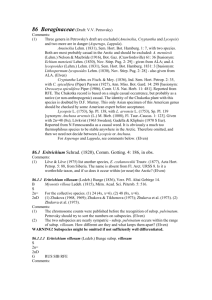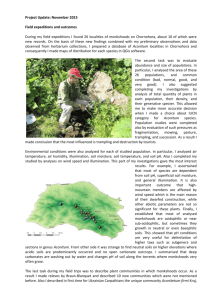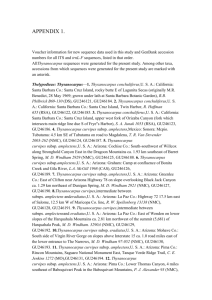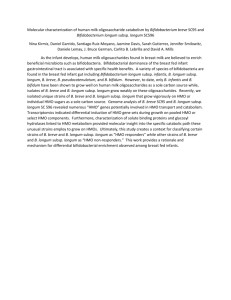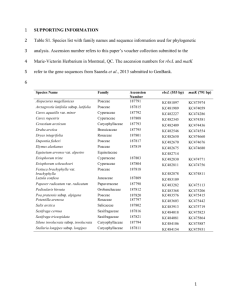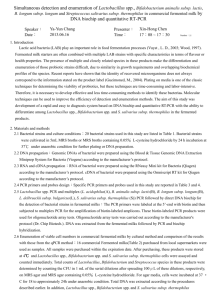Papaver(Papaver2)
advertisement
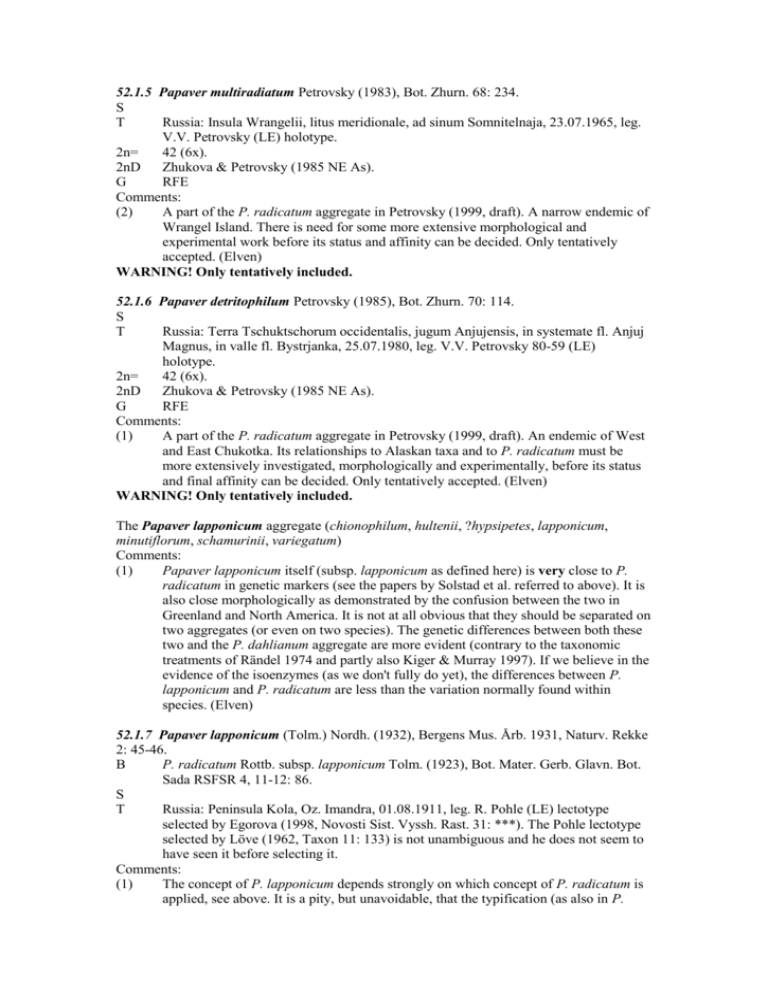
52.1.5 Papaver multiradiatum Petrovsky (1983), Bot. Zhurn. 68: 234. S T Russia: Insula Wrangelii, litus meridionale, ad sinum Somnitelnaja, 23.07.1965, leg. V.V. Petrovsky (LE) holotype. 2n= 42 (6x). 2nD Zhukova & Petrovsky (1985 NE As). G RFE Comments: (2) A part of the P. radicatum aggregate in Petrovsky (1999, draft). A narrow endemic of Wrangel Island. There is need for some more extensive morphological and experimental work before its status and affinity can be decided. Only tentatively accepted. (Elven) WARNING! Only tentatively included. 52.1.6 Papaver detritophilum Petrovsky (1985), Bot. Zhurn. 70: 114. S T Russia: Terra Tschuktschorum occidentalis, jugum Anjujensis, in systemate fl. Anjuj Magnus, in valle fl. Bystrjanka, 25.07.1980, leg. V.V. Petrovsky 80-59 (LE) holotype. 2n= 42 (6x). 2nD Zhukova & Petrovsky (1985 NE As). G RFE Comments: (1) A part of the P. radicatum aggregate in Petrovsky (1999, draft). An endemic of West and East Chukotka. Its relationships to Alaskan taxa and to P. radicatum must be more extensively investigated, morphologically and experimentally, before its status and final affinity can be decided. Only tentatively accepted. (Elven) WARNING! Only tentatively included. The Papaver lapponicum aggregate (chionophilum, hultenii, ?hypsipetes, lapponicum, minutiflorum, schamurinii, variegatum) Comments: (1) Papaver lapponicum itself (subsp. lapponicum as defined here) is very close to P. radicatum in genetic markers (see the papers by Solstad et al. referred to above). It is also close morphologically as demonstrated by the confusion between the two in Greenland and North America. It is not at all obvious that they should be separated on two aggregates (or even on two species). The genetic differences between both these two and the P. dahlianum aggregate are more evident (contrary to the taxonomic treatments of Rändel 1974 and partly also Kiger & Murray 1997). If we believe in the evidence of the isoenzymes (as we don't fully do yet), the differences between P. lapponicum and P. radicatum are less than the variation normally found within species. (Elven) 52.1.7 Papaver lapponicum (Tolm.) Nordh. (1932), Bergens Mus. Årb. 1931, Naturv. Rekke 2: 45-46. B P. radicatum Rottb. subsp. lapponicum Tolm. (1923), Bot. Mater. Gerb. Glavn. Bot. Sada RSFSR 4, 11-12: 86. S T Russia: Peninsula Kola, Oz. Imandra, 01.08.1911, leg. R. Pohle (LE) lectotype selected by Egorova (1998, Novosti Sist. Vyssh. Rast. 31: ***). The Pohle lectotype selected by Löve (1962, Taxon 11: 133) is not unambiguous and he does not seem to have seen it before selecting it. Comments: (1) The concept of P. lapponicum depends strongly on which concept of P. radicatum is applied, see above. It is a pity, but unavoidable, that the typification (as also in P. dahlianum) is made on an isolated, marginal population that deviates from the main body of the species. In the opinion of Petrovsky (1999, draft) - which we share subsp. lapponicum is restricted to the mountain (and valley) populations of N Norway and Kola Peninsula where it occurs in three separate areas: (A) The Kvænangen area in NE Troms province (Norway), where the populations was first described as a separate var. parviflorum Nordh. (1932), Bergens Mus. Årb. 1931, Naturv. Rekke 2: 46, later proposed as a separate subsp. kvaenangense (Lundström) Nilsson (in draft), based on P. nudicaule L. subsp. kvaenangense Lundström (1923), Acta Horti Berg. 7: 416. (B) The Alta area in W Finnmark province (Norway), where the populations were first described as a separate subsp. scandinavicum Knaben (1959), Opera Bot. 2, 3: 56, and later raised to species level as P. norvegicum N. Semen. in Pojark. (1956), Fl. Murm. Obl. 3: 369. (C) The Chibiny Mts. in central Kola Peninsula from where it is typified and where previous Russian botanists have separated the material on three species: P. lapponicum s. str., P. chibinense N. Semen. in Pojark. (1956), Fl. Murm. Obl. 3: 368, and P. tolmatchevii N. Semen. in Pojark. (1956), Fl. Murm. Obl. 3: 369. Those three last-mentioned are nearly entirely sympatric, each with 15-30 mapped 'occurrences' within a common area of about 40 x 40 km (Pojarkova 1956, maps 102104). The three Kola Peninsula 'species' are results of the previous 'nonotypic' species concept and are joined within subsp. lapponicum by Egorova (1998). An octoploid chromosome number is proved for both Norwegian population groups (Horn 1938, Knaben 1959). The investigations of genetic markers have until now been restricted to material from the Alta populations (subsp. scandinavicum sensu Knaben, subsp. lapponicum sensu Egorova, Petrovsky and us). Very few markers differentiate this octoploid from the decaploid 'races' of P. radicatum. From genetic evidence P. lapponicum subsp. lapponicum could be included in P. radicatum. From a geographical point of view, too, the N Fennoscandian populations fall inside or just outside the range of P. radicatum whereas they are well isolated from the rest of what is named as P. lapponicum in both directions. Until further evidence is available we should keep P. lapponicum together but we should be aware of the possibility that the future 'species' might exclude the type subspecies (with some nomenclatural repercussions) or perhaps be merged with P. radicatum. Subsp. lapponicum, which was included in Petrovsky's draft, is excluded here as it does not reach or even closely approach the Arctic as defined. (Elven) 52.1.7.1 Papaver lapponicum (Tolm.) Nordh. subsp. dasycarpum Tolm. (1932), Trav. Mus. Bot. Acad. Sci. URSS 24: 101. S 2n= 2nD G RUS Comments: (1) According to Tolmachev (1975), this is a local race of Novaya Zemlya where it cooccurs with P. dahlianum subsp. polare. The material deviates distinctly from P. lapponicum subsp. lapponicum and approaches P. dahlianum in some characters. This is evident from the significant part of it that Tolmachev annotated as P. polare (in LE) and which later has been transferred to P. lapponicum subsp. dasycarpum. Petrovsky (1999) also writes, "This subspecies probably also grows in several islands of the Siberian sector of the Arctic Ocean", but it is not clear where. The entity needs experimental comparison with both P. dahlianum subsp. polare and more southern P. lapponicum s. lat. before it can be fully accepted. (Elven) WARNING! An ambiguous entity as it stands, see comment. 52.1.7.2 Papaver lapponicum (Tolm.) Nordh. subsp. jugoricum (Tolm.) Tolm. (1932), Trav. Mus. Bot. Acad. Sci. URSS 24: 101. B P. radicatum Rottb. subsp. jugoricum Tolm. (1923), Bot. Mater. Herb. Bot. Gard. 4, 11-12: 86. S 2n= 56 (8x). 2nD Zhukova & Petrovsky (1985, 1987 N Russ). G RUS SIB Comments: (1) The chromosome counts refer to P. lapponicum subsp. jugoricum from Polar Ural. (Petrovsky) (2) A race of Polar Ural and northwesternmost Siberia (Yamal-Gydan) with a slight overlap with the next in the Jenisei area. This entity also needs a critical comparison with neighboring races and species before it can be fully accepted. The split of the NW Russian and Fennoscandian material of P. lapponicum s. lat. may be an effect of a less continuous distribution here than elsewhere and be a fairly recent (postglacial) phenomenon. The results from P. radicatum should warn us against over-description in such situations. (Elven) WARNING! An ambiguous entity as it stands, see comment. 52.1.7.3 Papaver lapponicum (Tolm.) Nordh. subsp. orientale Tolm. (1932), Tr. Polar. Komiss. 13: 131. S 2n= (1) 42 (6x). (2) 56 (8x). 2nD (1) ? (2) Zhukova (1968 ***); Zhukova & Petrovsky (1972 ***). G SIB RFE ALA CAN Comments: (1) Considered by Petrovsky (1999, draft) as the major race. Distributed from the Jenisei area eastwards through Siberia, Alaska and Canada, however, in the text (1999) given as "West American". Petrovsky's map (1999) also totally excludes Greenland from the range of P. lapponicum. The problems with this subspecies are therefore mainly on the North American side. (A) The 'labradoricum' problem. The relations to Knaben's P. lapponicum subsp. labradoricum in W Greenland and NE Canada is not made clear in the draft as the name is missing from Petrovsky's synonymy. The 'labradoricum' entity is probably included in P. radicatum in Petrovsky's concept of that species (see above). Kiger & Murray (1997) include the 'labradoricum' entity in their P. radicatum subsp. radicatum, but that is based on the probably erroneous Greenlandic typification of P. radicatum. If there is anything at all of importance in capsule shape and leaf dissection, subsp. labradoricum belongs in P. lapponicum (see Knaben 1959a, Pl. 6). If the two 'subspecies' are merged, the name 'orientale' 1932 has priority before 'labradoricum' 1958 at level of subspecies. In view of the confusion between P. lapponicum and P. radicatum, it must be confirmed to which of the 'species' the 'labradoricum' entity should belong. (B) The 'occidentale' problem. See also P. radicatum. The major body of non-Dahlianum Canadian plants were placed by Knaben (1959a, 1959b) in her P. lapponicum subsp. occidentale and her investigations showed it to be fairly homogeneous as poppies go (see Knaben 1959a, Pl. 5). Her experiments proved that crosses between Norwegian P. lapponicum subsp. lapponicum and Greenlandic 'occidentale' had c. 90% pollen fertility (the same level as between the two neighboring Norwegian areas of subsp. lapponicum) and c. 50% good seed (the same level as between many crosses between Norwegian races of P. radicatum). As far as experimental and morphological evidence goes, the 'occidentale' entity is therefore a P. lapponicum as long as subsp. lapponicum is kept inside P. lapponicum. As I commented under P. radicatum, there might be two major North Canadian entities besides P. dahlianum, but the 'occidentale' entity then belongs to the 'lapponicum' part of the variation and not the 'radicatum' part. It should therefore probably be compared with and perhaps considered synonymous with P. lapponicum subsp. orientale which then should be extended to include a large part of the Greenlandic plants. (Elven) 52.1.7.4 Papaver lapponicum (Tolm.) Nordh. subsp. porsildii (Knaben) Á. Löve *** S 2n= 56 (8x). 2nD Knaben (1959a, 1959b N Am). G ALA CAN Comments: (1) Included in P. radicatum subsp. radicatum (sensu Americans) by Kiger & Murray (1997). Knaben's (1959b) very scant crossing experiments involving this taxon involved subsp. labradoricum and what she called a 'intermediate type' from Greenland, both inside her concept of P. lapponicum. Both crosses gave fairly low pollen and seed fertility, at the level of crosses between species elsewhere in her experiments. Capsule (Knaben 1959a, Pl. 6) and leaf shape indicate 'lapponicum' rather than 'radicatum' in the North European concept. I am inclined to accept it as an American race but then its relations to the Russian subsp. orientale should be looked into. Knaben's material of what she named as subsp. porsildii was mainly from Prince Charles Island in the Foxe Basin, very far east and within the reach of both subsp. labradoricum and subsp. occidentale. (Elven) 52.1.8 Papaver variegatum Tolm. (1975), Arct Fl. URSS 7: 20. S T Russia: N Siberia: The Putorana plateau: ad litus meridionalis lacu Khantaika, prope ostium fluminis Mogaddy, 07.08.1970, leg. A. Tolmachev (LE) holotype. 2n= 42 (6x). 2nD *** G SIB Comments: (1) A fairly local entity of the Putorana plateau and southern Taimyr. Information insufficient for full evaluation. Petrovsky (1999) states that: "P. varigatum should be considered a subspecies of P. lapponicum, since it is only weakly distinguished from P. lapponicum s. str. Plants of similar appearance used to be referred to P. lapponicum s. l." I think we should follow that and include it in P. lapponicum, but that we perhaps should look at the total variation in what will become P. lapponicum (after the limit between P. lapponicum and P. radicatum is decided) before we assign rank. A comment is needed in any case. (Elven) WARNING! Might be reduced to a subspecies of P. lapponicum or to synonymy. 52.1.9 Papaver minutiflorum Tolm. (1960), Bot. Mater. Herb. Bot. Inst. Ac. Sc. USSR 20: 180. S T Russia: Yakutia, in regione alpina jugi montium Verchojanski, in ditione fluminis Tempo, 05.07.1957, leg. I. Kildjuschevski (LE) holotype. 2n= 2nD G SIB RFE Comments: (1) A disjunct entity known from the Kharaulakh area (northern Yakutia) and southern Chukotka. Information insufficient for final evaluation. Petrovsky (1999) states: "Papaver minutiflorum may only represent a small-flowered variety of P. lapponicum subsp. orientale." Its disjunct occurrence indicates the same and small-flowered plants of P. lapponicum are known from several areas, partly as population groups. Rändel (1974) was of a similar opinion [translated from German through Norwegian]: "As can be evaluated from the available specimens P. indirkense and P. minutiflorum have the morphological characteristics of P. lapponicum and can be included in P. lapponicum". Perhaps just synonymy, with a comment. (Elven) WARNING! Might be reduced to synonymy within P. lapponicum subsp. orientale. 52.1.10 Papaver hultenii Knaben (1959), Opera Bot. 3, 3: 49. S T USA: Alaskan Copper Mine River *** (O) holotype, see comment. 2n= 42 (6x). 2nD Löve & Löve (1975) list several arctic counts from NW America and NE Asia under this name. G RFE ALA Comments: (1) The type specimen is a plant raised from seed and cultivated in the Botanical Garden, University of Oslo. Maybe P. hultenii is the Alaskan form (variety) of P. lapponicum subsp. occidentale. (Petrovsky) (2) Kiger & Murray (1997) synonymize P. hultenii with P. lapponicum in a fairly restricted sense which excludes the 'occidentale' entity. There might, however, be a Beringian race in this complex but Petrovsky (1999) rather interprets P. hultenii as part of P. lapponicum subsp. orientale. We should perhaps follow that, with a comment. (Elven) WARNING! Will probably be reduced to synonymy within P. lapponicum. 52.1.11 Papaver schamurinii Petrovsky (1985), Bot. Zhurn. 70: 116. S T Russia: Insula Wrangelii, sinus Somnitelnaja, ad litus lacunae Bazovaja, 12.07.1971, leg. V.V. Petrovsky 71-200 (LE) holotype. 2n= 42 (6x). 2nD Zhukova & Petrovsky (1985 NE As). G SIB RFE ALA CAN Comments: (1) Mapped by Petrovsky (1999) from three different areas: Taimyr, Wrangel Island (typification) and N Alaska, in the text also mentioned for the Canadian Arctic Archipelago but not included from here in the map. It is mentioned for North America in a comment under P. lapponicum by Kiger & Murray (1997). The text of Petrovsky (1999) indicates that he also could accept this as a race (subspecies) of P. lapponicum. (Elven) WARNING! Might be reduced to a race of P. lapponicum, or perhaps to synonymy. 52.1.12 Papaver chionophilum Petrovsky (1983), Bot. Zhurn. 68: 233. S T Russia: Insula Wrangelii, ad sinum Somnitelnaja, ad fl. Somnitelnaja, 05.08.1971, leg. V.V. Petrovsky (LE) holotype. 2n= 56 (8x). 2nD Zhukova & Petrovsky (1985 NE As). G RFE Comments: (1) A local endemic of Wrangel Island. Petrovsky (1999) indicates it as possibly a variation within P. lapponicum subsp. orientale, but as octoploid in opposition to the otherwise hexaploid P. lapponicum (subsp. orientale) on Wrangel Island. However, the majority of P. lapponicum elsewhere (Greenland, Canada, western Russia, Norway) is also octoploid so this argument is not very strong. (Elven) WARNING! Might be reduced to a race of P. lapponicum or to synonymy. 52.1.13 Papaver hypsipetes Petrovsky (1985), Bot. Zhurn. 70: 113. S T Russia: Terra Tschuktschorum occidentalis, districtus Bilibinskij, montes Anjujensis, jugum Hirnejensis, ad lacus Hirnej Superior, 18.07.1973, leg. V.V. Petrovsky 73-26 (LE) holotype. 2n= 28 (4x). 2nD Zhukova & Petrovsky (1985 NE As). G RFE Comments: (1) A local endemic of West Chukotka mountains. The information is insufficient for final decision. As it is the most low-ploid member of the P. lapponicum aggregate (tetraploid) it should not be included in the otherwise similar subsp. orientale without careful evaluation and some experimental work. (Elven) 52.1.14 Papaver alaskanum Hultén (1937), Fl. Aleut. Isl. 190. S P. radicatum Rottb. subsp. alaskanum (Hultén) J.P. Anders. (1959), Fl. Alaska 244; P. microcarpum DC. subsp. alaskanum (Hultén) Tolm. (1975), Fl. Arct. URSS 7: 30. 2n= 42 (6x). 2nD Mulligan & Porsild (1969b NW Can). G ALA Comments: (1) Without studying type material a relation of P. alaskanum to P. radicatum or P. microcarpum is not clear. (Petrovsky) (2) As long as we don't have available the data needed to make a decision - as subspecies of P. radicatum (as preferred by Kiger & Murray 1997), subspecies of P. microcarpum (as preferred by Tolmachev 1975), or as separate species - we have to keep it as species. Tolmachev's proposal should perhaps be taken as an indication that he saw the P. microcarpum entities as comparatively closely related to P. radicatum? (Elven) (3) The material annotated as P. alaskanum or P. radicatum subsp. alaskanum from Alaska in ALA is heterogeneous. A re-evaluation of this entity is urgently needed before full acceptance and assignment to aggregate. (Elven & Solstad) The Papaver pulvinatum aggregate (?angustifolium, anjuicum, leucotrichum, mcconnellii, nivale, pulvinatum) Comments: (1) The circumscription of this aggregate is still very unclear. Petrovsky (1999) included P. macounii subsp. discolor and P. angustifolium with a question mark. As he there only listed the Russian taxa, we also have to include the Americans P. mcconnellii and P. macounii subsp. macounii, the latter as questionable. Petrovsky (1999) excluded P. keelei from this complex but that is a little problematic as Kiger & Murray (1997) synonymised P. keelei with P. macounii subsp. discolor. They also stated that specimens of P. paucistamineum from Chukotka fell inside the range of variation they accepted for P. macounii subsp. discolor. I have tentatively made a change from Petrovsky (1999, draft) by transfer of P. macounii and P. keelei to an extended P. macounii - paucistamineum aggregate. The problems seem at least partly to be linked with the current concept of P. macounii. This 'species' includes a mainly Beringian Sea Island large-flowered plant (subsp. macounii) that resembles the central parts of the P. pulvinatum aggregate and a mainland amphi-Beringian but mainly American and much more small-flowered plant (subsp. discolor) that much more resembles Petrovsky's (1999) P. keeleipaucistamineum aggregate. Kiger & Murray (1997) also - by an elegant understatement - indicated doubts about whether subsp. macounii and subsp. discolor really belong within the same species by stating that P. keelei would be the valid species name if subsp. discolor was accepted as a species of its own. (2) Very, very tentative results from some isoenzyme investigations in Oslo (Solstad unpubl.) might support a separation of subsp. macounii and subsp. discolor. However, the two plants become more similar in comparative cultivation than they are in field-collected material; 'discolor' becomes very large-flowered and 'macounii' becomes tall-grown. We should therefore discuss the possible re-structuring of the aggregates where the P. pulvinatum aggregate would contain P. pulvinatum, P. leucotrichum (as a race of P. pulvinatum?), P. angustifolium (perhaps only as a comment), P. anjuicum, P. mcconnellii, P. nivale, and P. macounii s. str. (possibly); the P. paucistamineum aggregate would contain P. paucistamineum, P. atrovirens, P. macounii subsp. discolor, and perhaps as a separate entry: P. keelei. (Elven) The map of the taxa of the aggregate presented by Petrovsky (1999) does not correspond with his text. There must have been an interchange of legends between P. angustifolium and P. leucotrichum, and P. pulvinatum subsp. interius is not in the map. (Elven)
